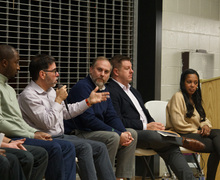Former Syracuse guard Richard Duffy remembered as devoted mentor, ‘fiery’ competitor
Daily Orange Archive Photo
Richard Duffy provided a veteran presence and was a 'great communicator' on the court
Get the latest Syracuse news delivered right to your inbox. Subscribe to our sports newsletter here.
The story of Syracuse men’s basketball catapulting onto the national stage can’t be told without a fierce point guard who was known as a smooth talker.
In 1962, the Orange finished their worst season in program history. An abysmal 2-22 record marked the end of head coach Marc Guley’s 12-year stint at the helm. Fred Lewis, a 36-year-old former Long Island University-Brooklyn standout, replaced Guley.
Lewis was set to inherit future NBA player Dave Bing, Chuck Richards — a talented center who transferred from Army — and Jim Boeheim, a walk-on from Lyons, New York. But Syracuse required a veteran presence. Lewis needed someone to guide his up-tempo play style and Richard Duffy, a scrappy sophomore guard from Katonah, New York, fit seamlessly into that mold.
“He was fiery,” former teammate Rex Trobridge said. “He didn’t back down from anybody.”
Duffy, despite suffering an injury his sophomore year to the cartilage in his knee, started at point guard for the majority of his three seasons with Syracuse. His ball handling skills and quickness led SU to its first postseason in seven years with a berth in the 1964 National Invitational Tournament. Duffy died last Thursday at the age of 80 in Wilmington, North Carolina, after dealing with multiple heart and lung issues.
Described by Boeheim as a “great communicator,” Duffy led Boeheim on his visit to Syracuse’s campus before he committed. The pair sparked a connection, one that turned into friendly competition in practice as Duffy’s “pure” point guard abilities matched up against Boeheim’s score-first mentality.

Arlo Stone | Digital Design Director
It was a time when, as Trobridge said, fans came to the freshman game at Manley to see Boeheim, Bing and Richards play, then leave before the varsity team began. Duffy was determined to bring the team together. His “outgoing” personality led to relationships with nearly every player, a trait he later translated into a successful advertising career.
“He could really communicate anything to anybody,” Boeheim said. “He could talk to anybody about anything. His whole life in advertising was just relationships.”
A few months after Richards started at Syracuse, he and Duffy routinely went on double dates with their eventual wives. All four would pile into Richards’ grandmother’s 1951 standard shift Dodge after practice and go to parties off-campus.
With the team, the pair headed out to different bars, namely Jimmy Benhams on the East Side of Syracuse. It led to a life-long relationship, most recently filled with phone calls about Big East basketball, golf outings and vacation planning.
According to Trobridge, the crop of players from 1962-65 still take a yearly trip to New Orleans in early November. Duffy hadn’t attended the reunions in recent years due to health issues, but he stayed in contact with Boeheim and the others, attending basketball games when he could.
“(Duffy) was always a diehard Syracuse fan and would follow us every game everywhere, just wherever he was,” Boeheim said.
On the court, Lewis was a perfectionist. He wouldn’t tear into players, but demanded an explanation for a missed screen or errant pass. Duffy’s knowledge of the game helped the team limit mistakes and understand plays. His “older leadership” role allowed Bing, Boeheim and Richards to quickly mature.
When Trobridge, who didn’t consistently play until his senior year, lost confidence as a freshman, Duffy took him aside. Trobridge struggled to coordinate his 6-foot-9 frame, casting self-doubt that he couldn’t play alongside Bing and Richards.

During the 1963-64 season, Duffy led Syracuse to the National Invite Tournament, breaking a seven year absence from the postseason Daily Orange Archive Photo
“‘Rex, you can do it,’” Duffy told Trobridge. “‘These guys put their pants on one leg at a time, just the way you do.’”
Duffy was also an avid baseball player and sports fan, dubbed by Trobridge as “an oracle and a student of all things sports.” He played catcher and third base for SU’s baseball team, becoming a three-year Letterwinner.
At John Jay (New York) High School, Duffy was a part of a New York Yankees-sponsored All-Star team. He picked up golf after college and found a final home, through Richards’ recommendation, in Southport, North Carolina, situated near three pristine golf courses. Though his knee injury forced Duffy away from the game, he played with his former teammates until he couldn’t.
“We played golf together. We played some basketball tournaments at his club,” Boeheim said. “So we were pretty close for a long time.”
Duffy averaged 8.7 points per game during his senior year and was a career 45.5% shooter, totalling 429 points across three seasons for the Orange. He let Boeheim pick his brain about the essential aspects of being a point guard and worked closely with Bing and Richards on pick-and-roll plays. Though Bing was the focal point of the offense by the 1962-63 season, Duffy was the catalyst, supplying opportunities for Bing.
Trobridge and others see their team as the foundation for “the modern era of Syracuse basketball.” Lewis had arrived fresh off a successful season at Southern Mississippi and recruited what turned into one of the best classes in SU history. Soon, under Lewis, SU evolved into a regular in the NIT and NCAA Tournaments.
Duffy mentored those who ushered in the beginning of Syracuse’s rise, serving as the switch between a 2-22 season and consistent success.
“All these years, 60 years, I know that he watched about every lacrosse game, football game, basketball game,” Richards said. “We would talk back and forth about the different victories in recruiting. He definitely loved his time at Syracuse.”

Published on May 11, 2023 at 2:31 am
Contact Anthony: aalandt@syr.edu | @anthonyalandt





